Important Questions for Class 12 Chemistry Chapter 4 Chemical Kinetics Class 12 Important Questions
Chemical Kinetics Class 12 Important Questions Very Short Answer Type
Question 1.
Define ‘rate of a reaction’. (Delhi 2010)
Answer:
Rate of a reaction: Either, The change in the concentration of any one of the reactants or products per unit time is called rate of a reaction. Or, The rate of a chemical reaction is the change in the molar concentration of the species taking part in a reaction per unit time.
Question 2.
Define ‘order of a reaction’. (All India 2011)
Answer:
The sum of powers of the concentration of the reactants in the rate law expression is called the order of reaction.
Question 3.
Define ‘activation energy’ of a reaction. (All India 2011)
Answer:
The minimum extra amount of energy absorbed by the reactant molecules to form the activated complex is called activation energy.
The activation energy of the reaction decreases by the use of catalyst.
Question 4.
Express the rate of the following reaction in terms of the formation of ammonia :
N2(g) + 3H2(g) → 2NH3(g) (Comptt. All India 2013)
Answer:
![]()
Question 5.
If the rate constant of a reaction is k = 3 × 10-4 s-1, then identify the order of the reaction. (Comptt. All India 2013)
Answer:
S-1 is the unit for rate constant of first order reaction.
Question 6.
Write the unit of rate constant for a zero order reaction. (Comptt. All India 2013)
Answer:
Mol L-1 S-1 is unit of rate constant for a zero order reaction.
Question 7.
Define rate of reaction. (Comptt. Delhi 2016)
Answer:
The change in concentration of reactant or product per unit time is called rate of reaction.
Question 8.
Define rate constant (K). (Comptt. All India 2016)
Answer:
Rate constant. It is defined as the rate of reaction when the concentration of reaction is taken as unity.
Question 9.
For a reaction R → P, half-life (t1/2) is observed to be independent of the initial concentration of reactants. What is the order of reaction? (Delhi 2017)
Answer:
The t1/2 of a first order reaction is independent of initial concentration of reactants.
Chemical Kinetics Class 12 Important Questions Short Answer Type -I [SA-I]
Question 10.
A reaction is of second order with respect to a reactant. How will the rate of reaction be affected if the concentration of this reactant is
(i) doubled, (ii) reduced to half? (Delhi 2009)
Answer:
Since Rate = K[A]2
For second order reaction Let [A] = a then Rate = Ka2
(i) If [A] = 2a then Rate = K (2a)2 = 4 Ka2
∴Rate of reaction becomes 4 times
(ii) If [A] = (frac{a}{2}) then Rate = K (left(frac{a}{2}right)^{2}=frac{mathrm{K} a^{2}}{4})
∴ Rate of reaction will be (frac{1}{4}^{text { th }}) .
Question 11.
Define the following :
(i) Elementary step in a reaction
(ii) Rate of a reaction (All India 2009)
Answer:
(i) Elementary step in a reaction: Those reactions which take place in one step are called elementary reactions.
Example : Reaction between H2, and I2 to form 2HI
H2 + I2 → 2HI
(ii) Rate of a reaction: The change in the concentration of any one of the reactants or products per unit time is called rate of reaction.
Question 12.
Define the following :
(i) Order of a reaction
(ii) Activation energy of a reaction (All India 2009)
Answer:
(i) Order of a reaction :
- It is the sum of powers of molar concentrations of reacting species in the rate equation of the reaction.
- It may be a whole number, zero, fractional, positive or negative.
- It is experimentally determined.
- It is meant for the reaction and not for its individual steps.
(ii) Activation energy of a reaction: The minimum extra amount of energy absorbed by the reactant molecules to form the activated complex is called activation energy.
Question 13.
A reaction is of first order in reactant A and of second order in reactant B. How is the rate of this reaction affected when (i) the concentration of B alone is increased to three times (ii) the concentrations of A as well as B are doubled? (Delhi 2010)
Answer:
r = K[A]1 [B]2
(i) When concentration of B increases to 3 times, the rate of reaction becomes 9 times
r = KA(3B)2 ∴ r = 9KAB2 = 9 times
(ii) r = K(2A) (2B)2 ∴ r = 8KAB2 = 8 times
Question 14.
The rate constant for a reaction of zero order in A is 0.0030 mol L-1 s-1. How long will it take for the initial concentration of A to fall from 0.10 M to 0.075 M? (Delhi 2010)
Answer:
For a zero order reaction,

Question 15.
Distinguish between ‘rate expression’ and ‘rate constant’ of a reaction. (Delhi 2011)
Answer:
Rate expression: The expression which expresses the rate of reaction in terms of molar concentrations of the reactants with each term raised to their power, which may or may not be same as the stoichiometric coefficient of that reactant in the balanced chemical equation.
Rate constant: The rate of reaction when the molar concentration of each reactant is taken as unity.
Question 16.
What do you understand by the rate law and rate constant of a reaction? Identify the order of a reaction if the units of its rate constant are : (i) L-1 mol s-1 (ii) L mol-1 s-1 (All India 2011)
Answer:
The rate of reaction is found to depend on α concentration of term of reactant A and β concentration term of reactant B
Then Rate of reaction ∝ [A]α [B]β
or Rate = K [A]α [B]β
This expression is called Rate law.
‘K’ in this expression is called Rate constant. Rate constant’s unit :
(i) Unit = L-1 mol s-1 → Zero order reaction
(ii) Unit = L mol-1 s-1 → Second order reaction.
Question 17.
The thermal decomposition of HCO2H is a first order reaction with a rate constant of 2.4 × 10-3 s-1 at a certain temperature. Calculate how long will it take for three-fourths of initial quantity of HCO2 H to decompose. (log 0.25 = -0.6021) (All India 2011)
Answer:
Given : K = 2.4 × 10-3

Question 18.
A reaction is of second order with respect to a reactant. How is the rate of reaction affected if the concentration of the reactant is reduced to half? What is the unit of rate constant for such a reaction? (All India 2011)
Answer:
Rate = K [A]2 = Ka2
If [A] = (frac{1}{2})a Rate = K (left(frac{a}{2}right)^{2}=frac{1}{4}) Ka2
∴ Rate = 1/4th (one fourth of origina rate)
The unit of rate constant is L mol-1 s-1
Question 19.
What do you understand by the ‘order of a reaction’? Identify the reaction order from each of the following units of reaction rate constant:
(i) L-1 mol s-1 (ii) L mol-1 s-1 (Delhi 2012)
Answer:
Order of reaction: The sum of powers of the concentration of the reactants in the rate law expression is called the order of that chemical reaction.
r = K[A]x[B]y Order = x + y
(i) Zero order
(ii) Second order
Question 20.
A reaction is of second order with respect to a reactant. How is its rate affected if the concentration of the reactant is (i) doubled (ii) reduced to half? (All India 2012)
Answer:
As Formula, r = K[R|2 …(Given)
(i) R’ = 2R ⇒ r = K[2R]-1 = 4KR-1
∴ Rate becomes 4 times than original rate

Question 21.
What is meant by rate of a reaction? Differentiate between average rate and instantaneous rate of a reaction. (Comptt. All India 2012)
Answer:
Rate of reaction: It is the change in concentration of the reactants or products in a unit time. Average rate : Average rate depends upon the change in concentration of reactants or products and the time taken for the change to occur. R → P

Instantaneous rate: It is defined as the rate of change in concentration of any one of the reactant or product at a particular moment of time.

Question 22.
(a) For a reaction A + B → P, the rate law is given by, r = k[A]1/2 [B]2.
What is the order of this reaction?
(b) A first order reaction is found to have a rate constant k = 5.5 × 10-14 s-1. Find the half life of the reaction. (All India 2013)
Answer:
(a) According to the formula : r = k[A]1/2 [B]2
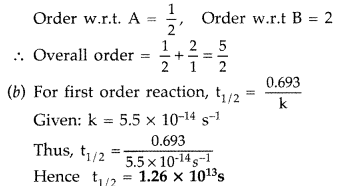
Question 23.
Rate constant k for a first order reaction has been found to be 2.54 × 10-3 sec-1. Calculate its 3/4th life, (log 4 = 0.6020). (Comptt. India 2013)
Answer:
For first order reaction:

Question 24.
A first order gas phase reaction : A2B2(g) → 2A(g) + 2B(g) at the temperature 400°C has the rate constant k = 2.0 × 10-4 sec-1. What percentage of A2B2 is decomposed on heating for 900 seconds? (Antilog 0.0781 = 1.197) (Comptt. All India 2013)
Answer:
Since the reaction is of the first order
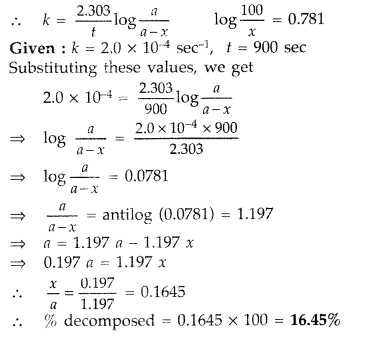
Question 25.
Write two differences between ‘order of reaction’ and ‘molecularity of reaction’. (Delhi 2014)
Answer:
| Order of reaction | Molecularity of reaction |
| (i) It is the sum of tire concentration terms on which die rate of reaction actually depends. | It is the number of atoms, ions or molecules that must collide with one another simultaneously so as to result into a chemical reaction. |
| (ii) It can be fractional as well as zero. | it is always a whole number. |
Question 26.
Define the following terms :
(a) Pseudo first order reaction.
(b) Half life period of reaction (t1/2). (Delhi 2014)
Answer:
(a) Those reactions which are not truly of the first order but under certain conditions become first order reactions are called pseudo first order reaction.
(b) The time taken for half of the reaction to complete is called half life period.
Question 27.
Explain the following terms :
(i) Rate constant (k)
(ii) Half life period of a reaction (t1/2) (Delhi 2014)
Answer:
(i) Rate constant (k): It is a proportionality constant and is equal to the rate of reaction when the molar concentration of each of the reactants is unity.
(ii) Half life period of a reaction (t1/2): The time taken for half of the reaction to complete is called half life penod.(R)t
Question 28.
For a chemical reaction R → P, the variation in the f concentration (R) vs. time (f) plot is given as
(i) Predict the order of the reaction.
(ii) What is the slope of the curve? (All India 2014)

Answer:
(i) It is zero order reaction.
(ii) Slope of the curve = -K
Question 29.
(a) For a reaction, A + B → Product, the rate law is given by, Rate = k[A]1[B]2. What is the order of the reaction?
(b) Write the unit of rate constant ‘k’ for the first order reaction. (Comptt. Delhi 2014)
Answer:
(a) For a reaction, A + B
Rate = k [A]1 [B]2
This is the third order of reaction.
(b) Unit of rate constant for first order reaction is S-1
Question 30.
Define the following terms :
(i) Rate constant (k)
(ii) Activation energy (Ea) (Comptt. Delhi 2014)
Answer:
(i) Rate constant (k): It is a proportionality constant and is equal to the rate of reaction when the molar concentration of each of the reactants is unity.
(ii) Activation energy (Ea): The minimum extra amount of energy absorbed by the reactant molecules to form the activated complex is called activation energy.
Question 31.
How does a change in temperature affect the rate, of a reaction? How can this effect on the rate constant of a reaction be represented quantitatively? (Comptt. All India 2014)
Answer:
The rate constant of a reaction increases with increase of temperature and becomes nearly double for every 10° rise in temperature.
The effect can be represented quantitatively by Arhenius equation K = Ae-Ea/RT
Where [Ea = Activation energy of the reaction; A = Frequency factor]
Question 32.
Define each of the following :
(i) Specific rate of a reaction
(ii) Energy of activation of a reaction (Comptt. All India 2014)
Answer:
(i) Specific rate of a reaction: Specific rate of reaction is the rate of reaction when the molar concentration of each of the reactants is unity.
(ii) Activation energy of a reaction: The minimum extra amount of energy absorbed by the reactant molecules so that their energy becomes equal to threshold value, is called activation energy.
Question 33.
A reaction is of second order with respect to its reactant. How will its reaction rate be affected if the concentration of the reactant is (i) doubled (ii) reduced to half? (Comptt. All India 2014)
Answer:
Since Rate = K[A]2
For second order reaction Let [A] = a then Rate = Ka2
(i) If [A] = 2a then Rate = K (2a)2 = 4 Ka2
∴Rate of reaction becomes 4 times
(ii) If [A] = (frac{a}{2}) then Rate = K (left(frac{a}{2}right)^{2}=frac{mathrm{K} a^{2}}{4})
∴ Rate of reaction will be (frac{1}{4}^{text { th }}) .
Question 34.
Define the following terms :
(i) Half-life of a reaction (t1/2)
(ii) Rate constant (k) (Comptt. Delhi 2015)
Answer:
(i) Half-life of a reaction (t1/2): Half-life period (t1/2) is the time in which half of the substance has reacted and its concentration is reduced to one-half of its initial concentration.
(ii) Rate constant (k): Rate constant may be defined as the rate of reaction when the molar concentration of each reactant is taken as unity.
Question 35.
Write units of rate constants for zero order and for the second order reactions if the concentration is expressed in mol L-1 and time in second. (Comptt. All India 2015)
Answer:
Using formula of rate constant,
K = [mol L-1]1 – n s-1 (n = order of rxn)
Unit for zero order reaction,
K = [mol L-1]1 – 0 s-1
K = [mol L-1] s-1 = mol L-1 s-1
Unit for second order reaction,
K = [mol L-1]1 – 2 = [mol L-1]-1 s-1
Question 36.
For a reaction: 2NH2(g) (stackrel{mathrm{Pt}}{longrightarrow}) N2(g) + 3H2(g)
Rate = k
(i) Write the order and molecularity of this reaction.
(ii) Write the unit of k. (Delhi 2016)
Answer:
2NH2(g) (stackrel{mathrm{Pt}}{longrightarrow}) N2(g) + 3H2(g)
(i) It is a zero order reaction and its molecularity is two.
(ii) Unit of k is mol L-1 s-1.
Question 37.
For a reaction: H2 + Cl2 (stackrel{mathrm{hv}}{longrightarrow}) 2HCl
Rate = k
(i) Write the order and molecularity of this reaction.
(ii) Write the unit of k. (All India 2016)
Answer:
H2 + Cl2 (stackrel{mathrm{hv}}{longrightarrow}) 2HCl
This reaction is zero order reaction and molecularity is two.
(ii) Unit of k = mol L-1 s-1
Question 38.
For a chemical reaction R → P, variation in ln[R] vs time (f) plot is given below:
For this reaction:
(i) Predict the order of reaction

(ii) What is the unit of rate constant (k)? (Comptt. Delhi 2017)
Answer:
(i) It is zero order reaction.
(ii) The unit of rate constant (k) is mol L-1 S-1.
Question 39.
(a) Explain why H2 and O2 do not react at room temperature.
(b) Write the rate equation for the reaction A2 + 3B2 → 2C, if the overall order of the reaction is zero. (Comptt. All India 2017)
Answer:
(i) H2 and O2 do not react at room temperature because they do not have enough activation energy to overcome the exceptionally high activation energy barrier.
(ii) A2 + 3B2 → 2C
Rate = (left(frac{d x}{d t}right)) = K[A]0 [B]0 = K (rate constant)
Question 40.
Derive integrated rate equation for rate constant of a first order reaction. (Comptt. All India 2017)
Answer:
In a first order reaction, the rate of reaction, is directly proportional to the concentration of the reactant.
Let us consider the reaction,
A → Products
The instantaneous reaction rate can be expressed as:
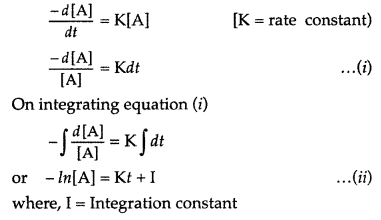
If t = 0 and [A] = [A]0, where [A]0 is the initial concentration of the reactant.
Then equation (ii) becomes
-ln[A]0 = I ……………. (iii)
Substitute the value of I in equation (ii)
-ln[A] = Kt – ln[A]
ln[A]0 – ln[A] = Kt
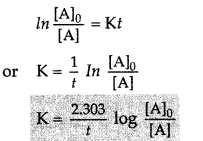
This is called integrated rate equation for the first order reaction.
Question 41.
(i) What is the order of the reaction whose rate constant has same units as the rate of reaction?
(ii) For a reaction A + H2O → B; Rate ∝ [A],
What is the order of this reaction? (Comptt. All India 2017)
Answer:
(i) The reaction whose rate constant has same units as the rate of reaction, will have zero order of reaction.
(ii) The reaction A + H2O → B Rate ∝ [A]
The order of this reaction will be pseudo first order reaction as the rate of reaction depends only on concentration of A only.
Chemical Kinetics Class 12 Important Questions Short Answer Type – II [SA-II]
Question 42.
A first order reaction has a rate constant of 0.0051 min-1. If we begin with 0.10 M concentration of the reactant, what concentration of reactant will remain in solution after 3 hours? (Delhi & All India 2009)
Answer:
Given : [R]0 = 0.10 M, t = 3 hrs = 180 min
K = 0.0051 min-1 [R] = ?
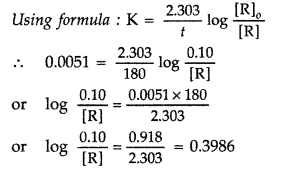
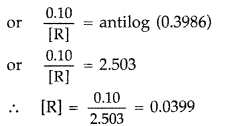
∴ Concentration of reactant remains 0.040 M
Question 43.
For a decomposition reaction the values of rate constant k at two different temperatures are given below :
k1 = 2.15 × 10-8 L mol-1 s-1 at 650 K
k2 = 2.39 × 10-7 L mol-1 s-1 at 700 K
Calculate the value of activation energy for this reaction.
(R = 8.314 J K-1 mol-1) (All India 2009)
Answer:
Given: k1 = 2.15 × 10-8 L mol-1 s-1, T1 = 650 K
k2 = 2.39 × 10-7 L mol-1 s-1, T2 = 700 K
R = 8.314 J K-1 mol-1 Ea =?
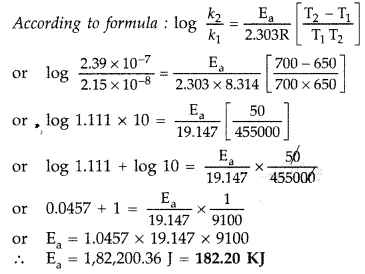
Question 44.
Nitrogen pentoxide decomposes according to equation :
2N2O5(g) → 4 NO2(g) + O2(g).
This first order reaction was allowed to proceed at 40°C and the data below were collected :
| [N2OJ (M) | Time (min) |
| 0.400 | 0.00 |
| 0.289 | 20.0 |
| 0.209 | 40.0 |
| 0.151 | 60.0 |
| 0.109 | 80.0 |
(a) Calculate the rate constant. Include units with your answer.
(b) What will be the concentration of N2O5 after 100 minutes?
(c) Calculate the initial rate of reaction. (Delhi 2009)
Answer:
(a) K = (frac{2.303}{t} log frac{left[mathrm{A}_{0}right]}{[mathrm{A}]})
Substituting the values, we get
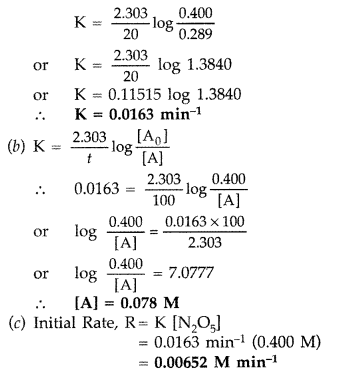
Question 45.
For the reaction
2NO(g) + Cl2(g) → 2NOCl(g) the following data were collected. All the measurements were taken at 263 K :
| Experiment No. | Initial [NO](M) | Initial
[Cl2](M) |
Initial rate of tlisa/ipcarance of Cl2 (M/min) |
| 1 | 0.15 | 0.15 | 0.60 |
| 2 | 0.15 | 0.30 | 1.20 |
| 3 | 0.30 | 0.15 | 2.40 |
| 4 | 0.25 | 0.25 | ? |
(a) Write the expression for rate law.
(b) Calculate the value of rate constant and specify its units.
(c) What is the initial rate of disappearance of Cl2 in exp. 4? (Delhi 2012)
Answer:
(a) Rate law = K[NO]2 [Cl2]
(b) 0.60 M min-1 = K[0.15]2 [0.15] M3
∴ K = 177.7 M-2 min-1
(c) Initial rate of disappearance of Cl2 in exp. 4
Formula : Rate = K[NO]2 [Cl2]
∴ Initial rate = 177.7M-2 min-1 × (0.25)2 × (0.25)M3
= 2.8 M min-1
Question 46.
(a) A reaction is first order in A and second order in B.
(i) Write differential rate equation.
(ii) How is rate affected when concentration of B is tripled?
(iii) How is rate affected when concentration of both A and B is doubled?
(b) What is molecularity of a reaction? (Comptt. All India 2009)
Answer:
(a) (i) Differential rate equation :
(frac{d x}{d t}) = rate = K [A]1 [B]2
(ii) Rate, r1 = K [A]1[B]2 …………… (i)
When concentration of B is increased three times then
Rate, r2 = K [A]1 [3B]2 ………..(ii)
Dividing equation (ii) by (i) we get
r2 = 9r1 rate increases by n*ne times.
(iii) When concentration of both A and B are doubled, then
r3 = K [2A]1 [2B]2 ………….. (iii)
Dividing equation {Hi) by (t), we get
r3 = 8r1
Hence rate increases by eight times.
(b) The number of reacting species (atoms, ions or molecules) taking part in an elementary reaction is called Molecularity of a reaction.
Question 47.
The rate of a reaction becomes four times when the temperature changes from 293 K to 313 K. Calculate the energy of activation (Ea) of the reaction assuming that it does not change with temperature. [R = 8.314 JK-1 mol-1, log 4 = 0.6021] (All India 2013)
Answer:
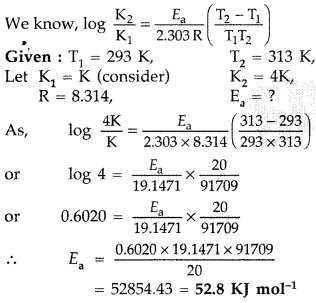
Question 48.
The following data were obtained during the first order thermal decomposition of SO2Cl2 at a constant volume :
SO2Cl2 (g) → SO2 (g) + Cl2(g)
| Experiment | Time/s_1 | Total pressure/atm |
| 1 | 0 | 0.4 |
| 2 | 100 | 0.7 |
Calculate the rate constant.
(Given : log 4 = 0.6021, log 2 = 0.3010) (Delhi, All India 2014)
Answer:
SO2Cl2 (g) → SO2 (g) + Cl2(g)
Using formula, K = (frac{2.303}{t} log frac{mathrm{P}_{0}}{2 mathrm{P}_{0}-mathrm{P}_{t}})
When t = 100 s
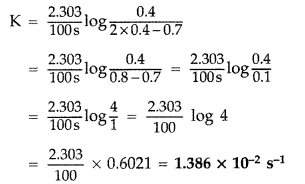
Question 49.
Hydrogen peroxide, H2O2 (aq) decomposes to H2O (l) and O2 (g) in a reaction that is first order in H2O2 and has a rate constant k = 1.06 × 10-3min-1.
(i) How long will it take for 15% of a sample of H2O2 to decompose?
(ii) How long will it take for 85% of the sample to decompose? (Comptt. Delhi 2014)
Answer:
(i) Given : k = 1.06 × 10-3min-1
For first order reaction
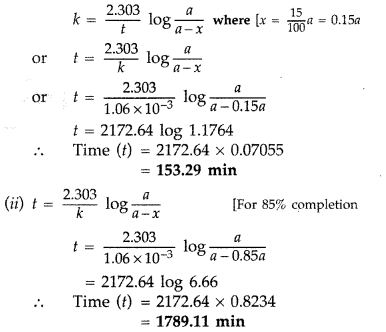
Question 50.
For a decomposition reaction, the values of k at two different temperatures are given below:
k1 = 2.15 × 10-8 L mol-1 s-1 at 650 K
k2 = 2.39 × 10-7 L mol-1 s-1 at 700 K
Calculate the value of activation energy for this reaction.
(Log 11.11 = 1.046) (R = 8.314 J K-1 mol-1) (Comptt. All India 2014)
Answer:
Given: k1 = 2.15 × 10-8 L mol-1 s-1, T1 = 650 K
k2 = 2.39 × 10-7 L mol-1 s-1, T2 = 700 K
R = 8.314 J K-1 mol-1 Ea =?

Question 51.
The rate constant of a reaction at 500 K and 700 K are 0.02 s-1 and 0.07 s-1 respectively. Calculate the value of activation energy, En (R = 8.314 J K-1 mol-1) (Comptt. Delhi 2015)
Answer:
Given : k2 = 0.07 s-1, k1, = 0.02 s-1, T1 = 500 K, T2 = 700 K, Ea = ?
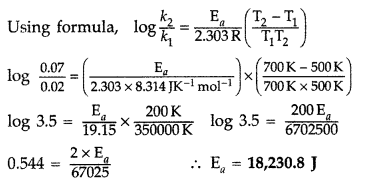
Question 52.
The rate constant for a first order reaction is 60 s-1. How much time will it take to reduce the initial concentration of the reactant to its l/10th value? (Comptt. All India 2015)
Answer:
Given : k = 60 s-1, t = ?
If initial concentration is [A0]

Question 53.
The rate constant for the first order decomposition of H2O2 is given by the following equation:
log k = 14.2 – (frac{1.0 times 10^{4}}{mathbf{T}} mathbf{K})
Calculate Ea for this reaction and rate constant k if its half-life period be 200 minutes.
(Given: R = 8.314 J K-1 mol-1) (Delhi 2016)
Answer:
Given: t1/2 = 200 min Ea = ?, T = ?
Using Arrhenius equation

Question 54.
For the first order thermal decomposition reaction, the following data were obtained:
C2H5Cl(g) → C2H4(g) + HCl(g)
Time/sec Total pressure/atm
0 0.30
300 0.50
Calculate the rate constant (Given: log 2 = 0.301, log 3 = 0.4771, log 4 = 0.6021) (All India 2016)
Answer:
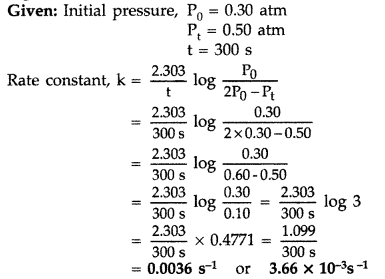
Question 55.
If the half-life period of a first order reaction in A is 2 minutes, how long will it take [A] to reach 25% of its initial concentration? (Comptt. Delhi 2016)
Answer:
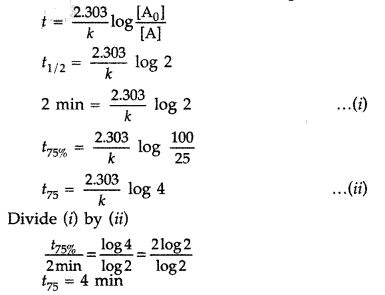
Question 56.
The rates of most reactions double when their temperature is raised from 298 K to 308 K. Calculate their activation energy. [R = 8.314 JK-1 mol-1] (Comptt. All India 2016)
Answer:
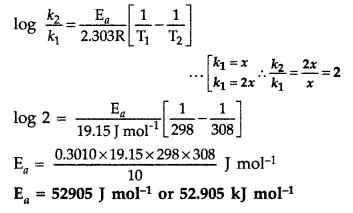
Question 57.
Following data are obtained for the reaction:
N2O5 → 2NO2 + (frac{1}{2})O2
| t/s | 0 | 300 | 600 |
| [N205]/mol L-1 | 1.6 × 10-2 | 0.8 × 10-2 | 0.4 × 10-2 |
(a) Show that it follows first order reaction.
(b) Calculate the half-life.
(Given log 2 = 0.3010 log 4 = 0.6021) (Delhi 2016)
Answer:
(a) For first order reaction:
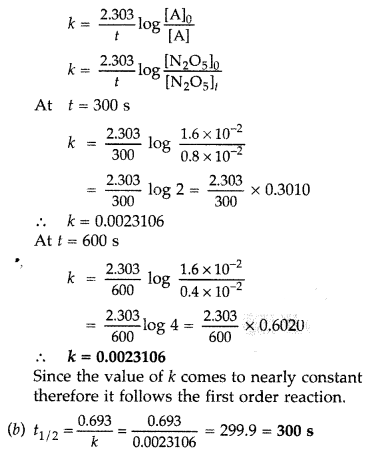
Question 58.
A first order reaction takes 20 minutes for 25% decomposition. Calculate the time when 75% of the reaction will be completed.
(Given: log 2 = 0.3010, log 3 = 0.4771, log 4 = 0.6021) (All India 2016)
Answer:
Given:
t = 20 min, A0 = 100%, A = 100 – 25 = 75%, k = ?
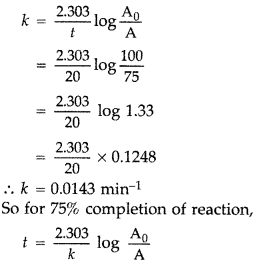

Question 59.
The following data were obtained during the first order thermal decomposition of SO2Cl2 at a constant volume :
| Experiment | Time(s) | Total pressure (atm) |
| 1 | 0 | 0.4 |
| 2 | 100 | 0.7 |
Calculate the rate constant (k).
[Given : log 2 = 0.3010; log 4 = 0.6021] (Comptt. Delhi 2016)
Answer:
SO2Cl2 (g) → SO2 (g) + Cl2(g)
Using formula, K = (frac{2.303}{t} log frac{mathrm{P}_{0}}{2 mathrm{P}_{0}-mathrm{P}_{t}})
When t = 100 s

Question 60.
For the first order decomposition of azoisopropane to hexane and nitrogen at 543 K , the following data were obtained :
Calculate the rate constant. The equation for the reaction is :
| Experiment | Time(s) | Total (mmHg) |
| 1 | 0 | 35.0 |
| 2 | 720 | 63.0 |
(CH3)2CHN = NCH(CH3)2 C6H14 (g) + N2 (g)
[Given : log 3 = 0.4771; log 5 = 0.6990] (Comptt. Delhi 2016)
Answer:
(CH3)2CHN = NCH(CH3)2 → N2 + C6H14
| Initial pressure | P0 | O | O |
| After time t | P0 – P | P | P |
Total Pressure after time t(Pt) = (P0 – P) + P + P
P = Pt – P0
a ∝ P0
(a – x) ∝ P0 – P
Substituting the value of P
a – x ∝ P0 – (Pt – P0)
or, (a – x) ∝ P0 – Pt
As decomposition of azoisopropane is a first order reaction


Question 61.
For a first order reaction, show that time required for 99% completion is twice the time required for completion of 90% reaction. (Comptt. All India 2016)
Answer:
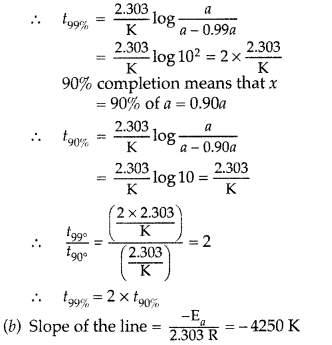
∴ Ea = 2.303 × 8.314 (JK-1 mol-1) × 4250 K
= 81.375 J mol-1 or 81.375 kJ mol-1
Question 62.
Half-life for a first order reaction 693 s. Calculate the time required for 90% completion of this reaction. (Comptt. All India 2016)
Answer:
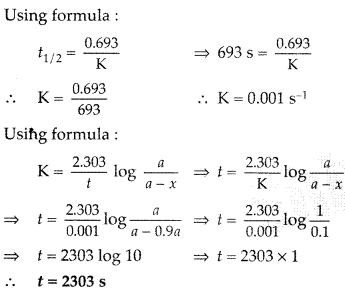
Chemical Kinetics Class 12 Important Questions Long Answer Type (LA)
Question 63.
(a) Explain the following terms :
(i) Rate of a reaction
(ii) Activation energy of a reaction (b) The decomposition of phosphine, PH3, proceeds according to the following equation:
4 PH3 (g) → P4 (g) + 6 H2 (g)
It is found that the reaction follows the following rate equation :
Rate = K [PH3].
The half-life of PH3 is 37.9 s at 120° C.
(i) How much time is required for 3/4th of PH3 to decompose?
(it) What fraction of the original sample of PH3 remains behind after 1 minute? (All India 2010)
Answer:
(a) (i) Rate of a reaction: The change in the concentration of any one of the reactants or products per unit time is called rate of reaction.
(ii) The minimum extra amount of energy absorbed by the reactant molecules to form the activated complex is called activation energy.
The activation energy of the reaction decreases by the use of catalyst.
(b) (i) According to the formula :
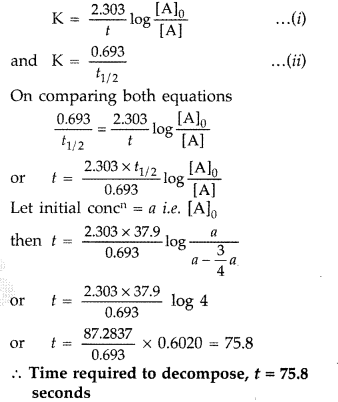

Question 64.
(a) Explain the following terms :
(i) Order of a reaction
(ii) Molecularity of a reaction
(b) The rate of a reaction increases four times when the temperature changes from 300 K to 320 K. Calculate the energy of activation of the reaction, assuming that it does not change with temperature. (R = 8.314 J K-1 mol-1) (All India 2016)
Answer:
(a) (i) Order of a reaction: It is the sum of powers of the molar concentrations of reacting species in the rate equation of the reaction.
(ii) Molecularity of a reaction :
- It is the total number of reacting species (molecules, atoms or ions) which bring the chemical change.
- It is always a whole number.
- It is a theoretical concept.
- It is meaningful only for simple reactions or individual steps of a complex reaction. It is meaningless for overall complex reaction.
(b) Given : T1 = 300 K T2 = 320 K
K1 = K (Consider)
K2 = 4 K R = 8.314 Ea = ?
Substituting these values in the formulae,
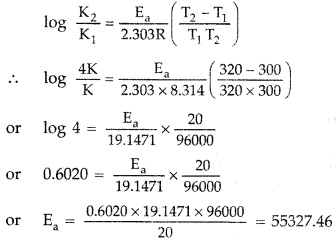
∴ Energy of activation, Ea = 55327.46 = 55.3 KJ mol-1
Question 65.
(a) With the help of a labelled diagram explain the role of activated complex in a reaction.
(b) A first order reaction is 15% completed in 20 minutes. How long will it take to complete 60% of the reaction ? (Comptt. Delhi 2012)
Answer:
(a) In order that the reactants may change into products, they have to cross an energy barrier as shown in the diagram

This diagram is obained by plotting potential energy vs. reaction coordinate. It is believed that when the reactant molecules absorb energy, their bonds are loosened and new bonds are formed between them. The intermediate complex thus formed is called activated complex. It is unstable and immediately dissociates to form the stable products.
(b) For the first order reaction

Question 66.
(a) What is the physical significance of energy of activation ? Explain with diagram.
(b) In general, it is observed that the rate of a chemical reaction doubles with every 10 degree rise in temperature. If the generalization holds good for the reaction in the temperature range of 295 K to 305 K, what would be the value of activation energy for this reaction ?
[R = 8.314 J mol-1 K-1] (Comptt. Delhi 2012)
Answer:
(a) The minimum extra amount of energy absorbed by the reactant molecules so that their energy becomes equal to threshold value is called activation energy. Less is the activation energy, faster is the reaction or greater is the activation energy, slower is the reaction



Question 67.
(a) A reaction is second order in A and first order in B.
(i) Write the differential rate equation,
(ii) How is the rate affected on increasing the concentration of A three times?
(iii) How is the rate affected when the concentrations of both A and B are doubled?
(b) A first order reaction takes 40 minutes for 30% decomposition. Calculate t1/2 for this reaction. (Given log 1.428 = 0.1548) (Delhi 2013)
Answer:
(a) (i) Differential rate equation :
(frac{d x}{d t}) = K [A]2[B]
(ii) When concentration of A is increased to three times, the rate of reaction becomes 9 times
r = K[3A]2B ∴ r = 9KA2B i.e. = 9 times
(iii) r = K[2A]2[2B] ∴ r = 8KA2B i.e. = 8 times
(b) Given : Time, t = 40 minutes, t =?
Let a = 100, ∴ x = 30% of 100 = 30
Using the formula :
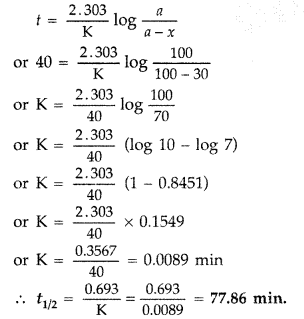
Question 68.
(a) For a first order reaction, show that time required for 99% completion is twice the time required for the completion of 90% of reaction. .
(b) Rate constant ‘k’ of a reaction varies with temperature ‘T’ according to the equation:
log k = log A – (frac{mathrm{E}_{a}}{2.303 mathrm{R}}left(frac{1}{mathrm{T}}right))
where Ea is the activation energy. When a graph is plotted for log k vs. (frac{1}{overline{mathbf{T}}}),a straight line with a slope of – 4250 K is obtained. Calculate ‘Ea‘ for the reaction. (R = 8.314 JK-1 mol-1) (Delhi 2013)
Answer:

∴ Ea = 2.303 × 8.314 (JK-1 mol-1) × 4250 K
= 81.375 J mol-1 or 81.375 kJ mol-1
Question 69.
(a) The decomposition of A into products has a value of K as 4.5 × 103 s-1 at 10°C and energy of activation 60 kj mol-1. At what temperature would K be 1.5 × 104 s-1?
(b) (i) If half life period of a first order reaction is x and 3/4,th life period of the same reaction is y, how are x and y related to each other?
(ii) In some cases it is found that a large number of colliding molecules have energy more than threshold energy, yet the reaction is slow. Why? (Comptt. Delhi 2013)
Answer:
(a) Given : K1 = 4.5 × 103 s-1,
T1 = 10K + 273K = 283K
K2 = 1.5 × 104 s-1, T2 = ?
Ea = 60 KJ mol-1
Using formula :
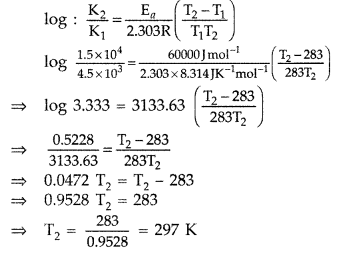
∴ Temperature, T2 will be = 297° – 273° = 24° C
(b) (i) t1/2 = (frac{0.693}{mathrm{K}}) (For first order reaction)
t3/4 = K ⇒ t3/4 = (frac{1.3864}{mathrm{K}})
According to condition
(The value 1.3864 is double of 0.693)
From the above equation it is clear that
t3/4 = 2t1/2 ∴ y = 2X
(ii) It is due to improper orientation of the colliding molecules at the time of collision.
Question 70.
(a) A first order reaction takes 100 minutes for completion of 60% of the reaction. Find the time when 90% of the reaction will be completed.
(b) With the help of diagram explain the role of activated complex in a reaction. (Comptt. Delhi 2013)
Answer:
(a) For the first order reaction,
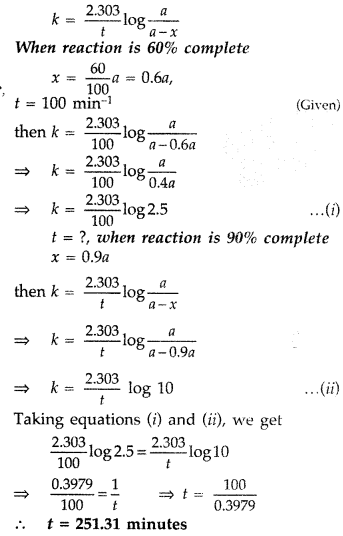
(b) In order that the reactants may change into products, they have to cross an energy barrier as shown in the diagram

This diagram is obained by plotting potential energy vs. reaction coordinate. It is believed that when the reactant molecules absorb energy, their bonds are loosened and new bonds are formed between them. The intermediate complex thus formed is called activated complex. It is unstable and immediately dissociates to form the stable products.
Question 71.
For the hydrolysis of methyl acetate in aqueous solution, the following results were obtained :
| t/s | 0 | 30 | 60 |
| [CH3COOCH3]/mol L-1 | 0.60 | 0.30 | 0.15 |
(i) Show that it follows pseudo first order reaction, as the concentration of water remains constant.
(ii) Calculate the average rate of reaction between the time interval 30 to 60 seconds. (Given log 2 = 0.3010, log 4 = 0.6021) (Delhi 2015)
Answer:
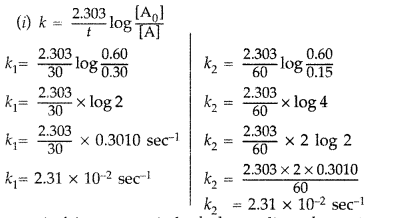
As k is constant in both the readings, hence it is a pseudo first order reaction.
(ii) Rate = – Δ[R] /Δt, Average rate between 30 to 60 seconds
= (frac{-(0.15-0.30)}{60-30}=frac{0.15}{30})
= 0.5 × 10-2 mol L-1 sec-1
Question 72.
(a) For a reaction A + B → P, the rate is given by Rate = k[A] [B]2
(i) How is the rate of reaction affected if the concentration of B is doubled?
(ii) What is the overall order of reaction if A is present in large excess?
(b) A first order reaction takes 30 minutes for 50% completion. Calculate the time required for 90% completion of this reaction.
(log 2 = 0.3010) (Delhi 2015)
Answer:
(a) For the reaction A + B → P rate is given
by Rate = k[A]1[B]2
(i) r1 = k[A]1 [B]2
r2 = k[ A]1[2B]2 =
r2 = k[A]1 [2B]2=4k[A]1 [B]2
r1 = 4r2, rate will increase four times of actual rate.
(ii) When A is present in large amount, order w.r.t. A is zero.
Hence overall order = 0 + 2 = 2, second order reaction.


Question 73.
For the hydrolysis of methyl acetate in aqueous solution, the following results were obtained:
| t/s | 0 | 10 | 20 |
| [CH3COOCH3]/mol L-1 | 0.10 | 0.05 | 0.025 |
(i) Show that it follows pseudo first order reaction, as the concentration of water remains constant.
(ii) Calculate the average rate of reaction between the time interval 10 to 20 seconds. (Given : log 2 = 0.3010, log 4 = 0.6021) (All India 2015)
Answer:
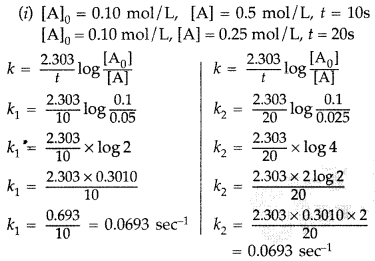
As k1 and k2 are equal, hence pseudo rate constant is same.
It follows the pseudo first order reaction.
(ii) Average rate of reaction between 10 to 20 seconds
= (frac{-Delta[mathrm{R}]}{Delta t}=frac{-(0.025-0.05)}{(20-10)}=frac{0.025}{10})
= 0.0025 mol lit-1 sec-1
Question 74.
(a) For a reaction A + B → P, the rate is given by Rate = k[A] [B]2
(i) How is the rate of reaction affected if the concentration of B is doubled?
(ii) What is the overall order of reaction if A is present in large excess?
(b) A first order reaction takes 30 minutes for 50% completion. Calculate the time required for 90% completion of this reaction. (All India 2015)
Answer:
(a) For the reaction A + B → P
rate is given by Rate = k[A]1[B]2
(i) r1 = k[A]1 [B]2
r2= k[A]1 [2B]2 = 4k[A]1 [B]2
r1 = 4r2 (rate of reaction becomes 4 times)
(ii) When A is present in large amounts, order w.r.t. A is zero.
Hence overall order = 0 + 2 = 2
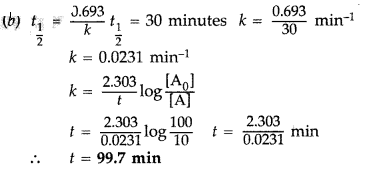
Important Questions for Class 12 Chemistry
<!–
–>